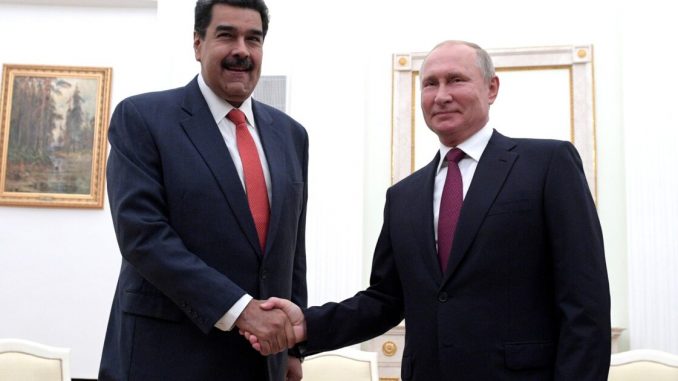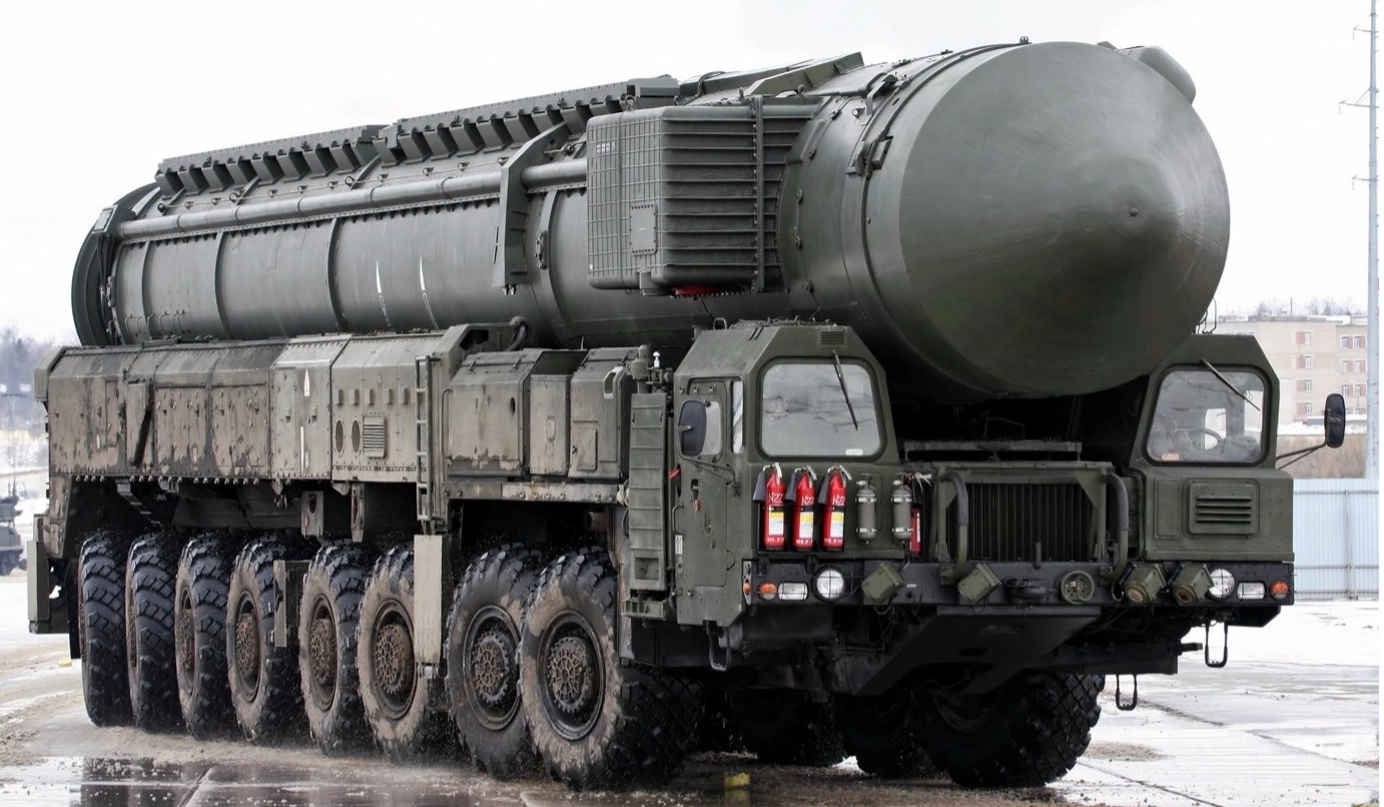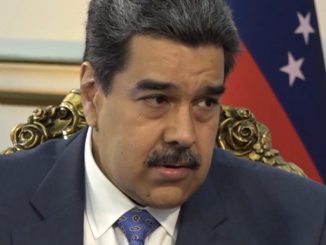
Credit: Wikimedia Commons via The Kremlin
Published November 5, 2025
A New Flashpoint Near America’s Shores
Reports from multiple international outlets indicate that Russia is considering supplying Venezuela with some of its most advanced weaponry — including hypersonic and cruise missiles — amid rising tensions with the United States.
The proposal, first mentioned by Russian lawmaker Alexei Zhuravlyov, deputy chairman of the State Duma’s defense committee, suggests that Moscow “sees no obstacles” to providing Venezuela with Oreshnik hypersonic missiles or Kalibr cruise missiles as part of what Russia describes as “defensive cooperation.”
While Russian officials have not confirmed an active transfer, Zhuravlyov’s comments have raised alarms in Washington and revived memories of Cold War–era brinkmanship. The statement comes just as the U.S. has expanded its military presence in the Caribbean, citing anti-drug operations and maritime security concerns.
Kremlin’s Strategic Messaging
According to the Washington Times, the Kremlin characterized any potential missile deployment as a “sovereign decision” between Russia and Venezuela, emphasizing that Moscow would act in response to “provocations” from the United States. Kremlin spokesperson Dmitry Peskov reportedly said that the U.S. had “no right to dictate” how sovereign nations defend themselves.
Moscow’s comments come as Russian forces continue operations in Ukraine, but analysts say the rhetoric toward Venezuela is as much about strategic signaling as actual military logistics. Placing advanced Russian systems in Latin America — even hypothetically — challenges the long-standing U.S. assumption of security dominance in its own hemisphere.
In recent years, Russia has strengthened ties with several left-leaning Latin American governments, particularly Venezuela, Cuba, and Nicaragua. These relationships provide Moscow with diplomatic allies and potential access points for projecting influence beyond Europe and Asia.
Caracas Seeks Support Amid U.S. Pressure
Venezuelan President Nicolás Maduro has faced mounting pressure from Washington over his government’s human rights record, economic collapse, and alleged corruption. The United States has imposed sanctions on Venezuela’s oil industry, restricted its access to global markets, and backed calls for democratic reforms.
In response, Maduro has deepened alliances with Russia, China, and Iran — seeking military and economic support to counterbalance U.S. power. Venezuelan officials have publicly welcomed Russian assistance in maintaining their air defense and radar systems, which were originally supplied by Moscow in the 2000s under former President Hugo Chávez.
Local sources reported that Russian technicians and advisors have been active in Venezuela, assisting with the maintenance of S-300 and Buk air defense platforms. New cooperation agreements could expand that partnership to include more sophisticated missile technologies.
For Maduro, such ties serve both strategic and political purposes. They bolster his domestic image as a leader resisting “imperialist aggression,” while providing deterrence against perceived threats from Washington and neighboring countries aligned with the U.S.
U.S. Military and Diplomatic Reactions
The potential for advanced Russian weapons appearing in the Caribbean has prompted concern among U.S. defense analysts and policymakers. Though no missile transfers have been confirmed, even the suggestion of deployment in Venezuela — less than 2,000 kilometers from Florida — carries serious geopolitical weight.
Pentagon officials have reportedly increased surveillance and naval patrols near Venezuelan waters. The U.S. Navy has maintained a carrier strike group in the Caribbean Sea, officially part of anti-narcotics operations but widely seen as a deterrent posture.
A senior U.S. defense source quoted by The Mirror warned that any move to install long-range or hypersonic missiles in Venezuela would be viewed as “a direct threat to the U.S. homeland” and could trigger a “decisive response.”
Meanwhile, diplomatic channels between Washington and Moscow have grown increasingly strained. The U.S. State Department called on Russia to “avoid destabilizing actions” and reaffirmed that “any attempt to introduce offensive weapons into the Western Hemisphere would not go unanswered.”
Echoes of the Cold War
Observers have drawn historical parallels to the 1962 Cuban Missile Crisis, when the Soviet Union’s deployment of nuclear-capable missiles to Cuba brought the world to the brink of nuclear war. While today’s circumstances differ — with no confirmed deployment and no nuclear payloads mentioned — the psychological impact is similar.
Both Russia and the United States are using symbolic military gestures to project strength in contested regions. For Moscow, talk of missile transfers to Venezuela serves as a reminder that it can challenge U.S. influence near its borders, just as Washington supports Ukraine and NATO operations near Russia’s western flank.
For Washington, the development underscores the return of great-power competition beyond Europe and Asia — a strategic environment where no region is off-limits, and deterrence must be managed on multiple fronts simultaneously.
An Evolving Balance of Power
As the rhetoric intensifies, regional governments are watching closely.
Countries like Colombia, Brazil, and Guyana — all wary of Venezuela’s militarization — have expressed concern over the growing Russian presence. Others, including Cuba and Nicaragua, have voiced support for Caracas, framing the U.S. naval buildup as an act of provocation.
Diplomats note that the region risks renewed polarization, reminiscent of Cold War alliances, with Washington and Moscow once again vying for influence through political, economic, and military partnerships.
Whether the proposed missile cooperation becomes reality or remains a strategic bluff, one thing is clear: the geopolitical calm that once defined the Americas is fading. The Caribbean, long considered a quiet sphere of trade and tourism, is reemerging as a potential stage for global power rivalry — and the world is watching to see what happens next.

(A Russian Ministry of Defense handout image which claims to show the Oreshnik medium range ballistic missile.)
 Implications
Implications
This is one of the most geopolitically significant developments in the Western Hemisphere since the Cuban Missile Crisis of 1962 — not because the situation is identical, but because it reopens the idea of strategic weapons stationed near U.S. territory by a rival power.
🌎 1. Global Implications
🔹 A New Cold War Line
-
Russia’s decision (even if still under discussion) to send missiles to Venezuela symbolically establishes a Western Hemisphere foothold for Moscow, effectively bringing the Eurasian confrontation into the Americas.
-
It mirrors NATO’s presence in Eastern Europe near Russia’s borders — a deliberate tit-for-tat positioning meant to remind Washington that global containment cuts both ways.
🔹 Strain on U.S.–Russia Relations
-
Washington will interpret any deployment as strategic encroachment, prompting countermeasures such as:
-
Increased surveillance and naval patrols near the Caribbean.
-
Possible missile defense upgrades in Puerto Rico, Florida, or nearby U.S. territories.
-
Diplomatic isolation efforts against Caracas and new sanctions targeting Russian defense exports.
-
🔹 Potential for a Security Spiral
-
Once one side moves advanced weapons, the other responds, and tensions escalate.
-
The more each side “signals strength,” the greater the chance of miscalculation or military incident — particularly in contested Caribbean waters.
🇻🇪 2. Implications for Venezuela
🔹 Political Shield for Maduro
-
The announcement alone strengthens Maduro’s image domestically as standing up to U.S. “imperialism.”
-
It reassures loyalists and the military that Caracas has Russia’s backing — a psychological and strategic boost amid economic collapse and internal dissent.
🔹 Increased Dependence on Moscow
-
Russia could leverage this alliance for oil contracts, gold access, or military basing rights in exchange for protection.
-
Venezuela’s sovereignty becomes more symbolic — as it drifts into being a regional outpost for Russian power projection.
🔹 U.S. Retaliation Risks
-
Sanctions could expand to Venezuela’s oil exports or shipping routes.
-
Any confirmed deployment might prompt U.S. cyber or covert operations to sabotage systems, as seen with Iran’s nuclear program.
🇺🇸 3. Implications for the United States
🔹 Strategic Shock in the Western Hemisphere
-
The U.S. has not faced a near-border missile threat since the Cold War.
-
Even a small deployment in Venezuela would compel new defense budgets and repositioning of assets to the south — a region previously considered stable.
🔹 Domestic Political Fallout
-
Expect pressure on the administration (and Trump, if still in office or running again) to respond decisively.
-
Critics may frame inaction as weakness; hawks could call for a naval blockade or “Monroe Doctrine” enforcement — reviving the historic U.S. policy of opposing outside powers in the Americas.
⚔️ 4. Regional Implications (Latin America & Caribbean)
🔹 Polarization
-
Cuba, Nicaragua, and Bolivia could align more tightly with Russia.
-
Colombia, Brazil, and Caribbean democracies would side with the U.S., reviving a bloc-based regional divide unseen since the 1980s.
🔹 Risk of Militarization
-
If missiles are actually deployed, neighboring countries could invite more U.S. troops or radar systems.
-
The Caribbean Sea could become a strategic flashpoint, complicating trade and tourism.
💣 5. Military Implications
🔹 Hypersonic Missiles = Limited U.S. Reaction Time
-
Hypersonic weapons (travelling over Mach 5) drastically cut warning times for the U.S. mainland — possibly under 10 minutes to reach Florida.
-
This could render traditional air defenses less effective and pressure Washington to expand early warning systems.
🔹 Intelligence & Cyber Warfare Expansion
-
The U.S. will likely intensify electronic surveillance and satellite tracking over Venezuela.
-
Russia, in turn, may deploy cyber and EW (electronic warfare) capabilities to mask activity, making the Caribbean an active digital battleground.
💬 6. Symbolic Implications
-
For Russia: “We can play in your backyard, too.”
-
For Venezuela: “We are no longer isolated.”
-
For the U.S.: “The post–Cold War comfort zone is gone.”
 Overall Takeaway:
Overall Takeaway:
Russia’s talk of deploying hypersonic missiles to Venezuela has already accomplished what Moscow likely intended — to rattle Washington, reassure Caracas, and remind the world that the Cold War’s ghost still lingers in new forms. Whether or not the missiles ever arrive, the strategic message is unmistakable: the Western Hemisphere is no longer a sanctuary from global rivalry.
For Venezuela, it signals defiance — a desperate but calculated move to secure protection from an ally with the firepower to deter intervention. For Russia, it’s a low-cost, high-impact gambit that projects power far from its borders and tests America’s resolve close to home. For the United States, it marks a sobering reality check: threats once imagined only across oceans could soon emerge within minutes of its shores.
In essence, this development may not ignite a new war, but it reignites an old tension — the contest between influence and proximity, sovereignty and deterrence. The coming months will reveal whether diplomacy can cool the heat now rising in the Caribbean, or whether the world is witnessing the early sparks of a new geopolitical standoff — one missile shipment away from reshaping the balance of power once again.
SOURCES: THE GATEWAY PUNDIT – Russia May Send Hypersonic Missiles to Venezuela as Defense Against Regime Change: ‘America May Be in For Some Surprises’
WASHINGTON TIMES – Russia should give Venezuela top missiles as tensions with U.S. rise, says Kremlin official
THE MIRROR – Venezuela war fears stoked as Russia risk Trump’s wrath with latest move





Be the first to comment